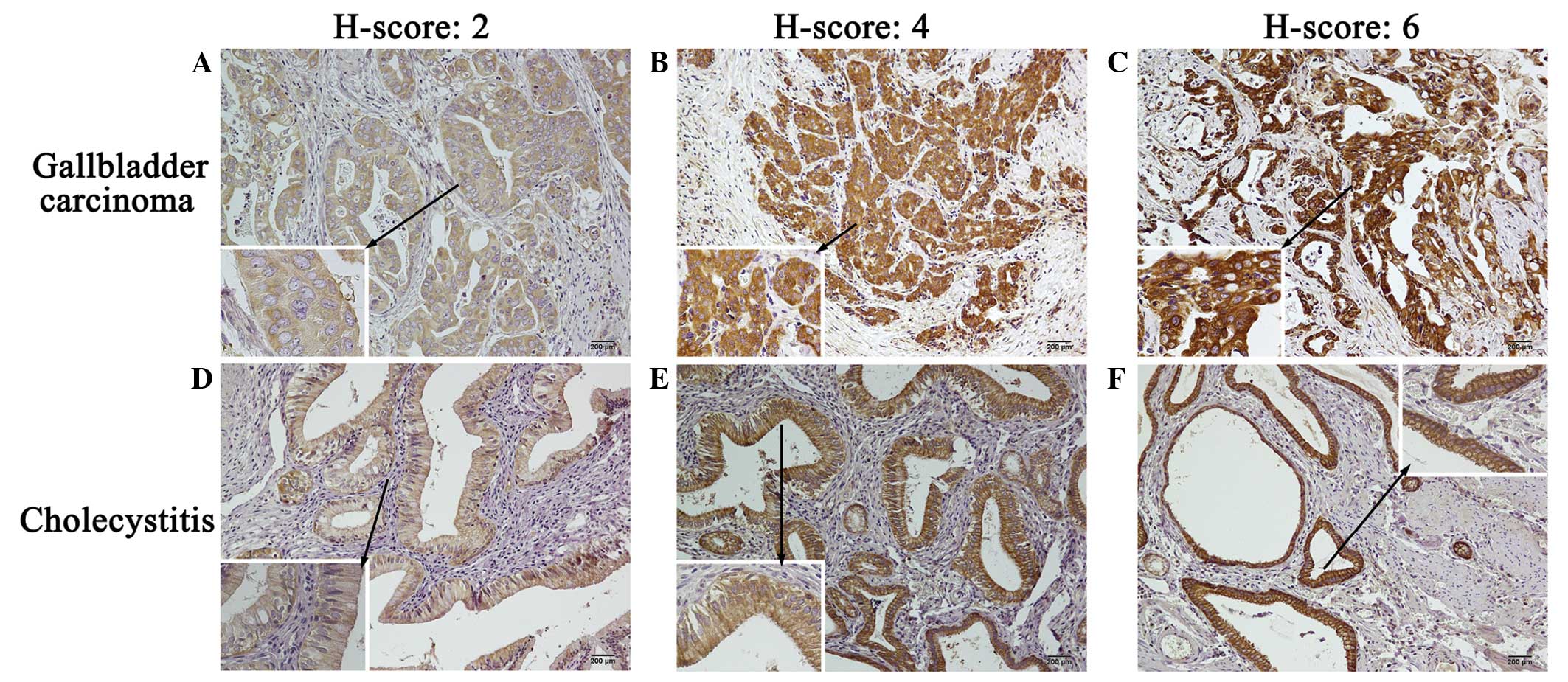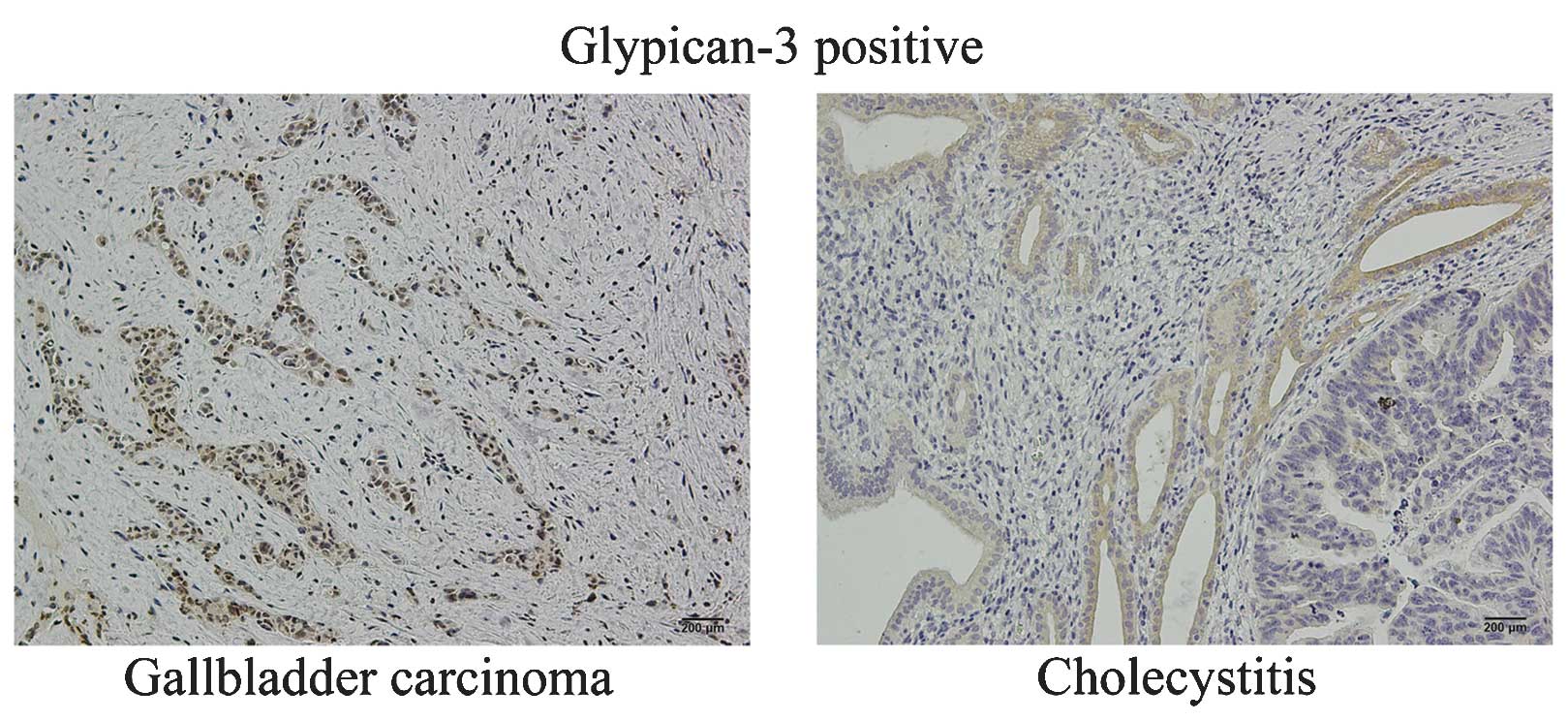|
1
|
Hundal R and Shaffer EA: Gallbladder
cancer: Epidemiology and outcome. Clin Epidemiol. 6:99–109.
2014.PubMed/NCBI
|
|
2
|
Ferlay J, Soerjomataram I, Dikshit R, Eser
S, Mathers C, Rebelo M, Parkin DM, Forman D and Bray F: Cancer
incidence and mortality worldwide: Sources, methods and major
patterns in GLOBOCAN 2012. Int J Cancer. 136:E359–E386. 2015.
View Article : Google Scholar : PubMed/NCBI
|
|
3
|
Henson DE, Albores-Saavedra J and Corle D:
Carcinoma of the gallbladder. Histologic types, stage of disease,
grade, and survival rates. Cancer. 70:1493–1497. 1992. View Article : Google Scholar : PubMed/NCBI
|
|
4
|
Åndrén-Sandberg A and Deng Y: Aspects on
gallbladder cancer in 2014. Curr Opin Gastroenterol. 30:326–331.
2014. View Article : Google Scholar : PubMed/NCBI
|
|
5
|
Sheth S, Bedford A and Chopra S: Primary
gallbladder cancer: Recognition of risk factors and the role of
prophylactic cholecystectomy. Am J Gastroenterol. 95:1402–1410.
2000. View Article : Google Scholar : PubMed/NCBI
|
|
6
|
Misra S, Chaturvedi A, Misra NC and Sharma
ID: Carcinoma of the gallbladder. Lancet Oncol. 4:167–176. 2003.
View Article : Google Scholar : PubMed/NCBI
|
|
7
|
Benyamin Y: The structural basis of
calpain behavior. FEBS J. 273:3413–3414. 2006. View Article : Google Scholar : PubMed/NCBI
|
|
8
|
Storr SJ, Woolston CM, Barros FF, Green
AR, Shehata M, Chan SY, Ellis IO and Martin SG: Calpain-1
expression is associated with relapse-free survival in breast
cancer patients treated with trastuzumab following adjuvant
chemotherapy. Int J Cancer. 129:1773–1780. 2011. View Article : Google Scholar : PubMed/NCBI
|
|
9
|
Huang Y and Wang KK: The calpain family
and human disease. Trends Mol Med. 7:355–362. 2001. View Article : Google Scholar : PubMed/NCBI
|
|
10
|
Kamei M, Webb GC, Young IG and Campbell
HD: SOLH, a human homologue of the Drosophila melanogaster
small optic lobes gene is a member of the calpain and zinc-finger
gene families and maps to human chromosome 16p13.3 near CATM
(cataract with microphthalmia). Genomics. 51:197–206. 1998.
View Article : Google Scholar : PubMed/NCBI
|
|
11
|
Ho M and Kim H: Glypican-3: A new target
for cancer immunotherapy. Eur J Cancer. 47:333–338. 2011.
View Article : Google Scholar : PubMed/NCBI
|
|
12
|
Capurro MI, Xiang YY, Lobe C and Filmus J:
Glypican-3 promotes the growth of hepatocellular carcinoma by
stimulating canonical Wnt signaling. Cancer Res. 65:6245–6254.
2005. View Article : Google Scholar : PubMed/NCBI
|
|
13
|
Capurro MI, Xu P, Shi W, Li F, Jia A and
Filmus J: Glypican-3 inhibits Hedgehog signaling during development
by competing with patched for Hedgehog binding. Dev Cell.
14:700–711. 2008. View Article : Google Scholar : PubMed/NCBI
|
|
14
|
Zittermann SI, Capurro MI, Shi W and
Filmus J: Soluble glypican 3 inhibits the growth of hepatocellular
carcinoma in vitro and in vivo. Int J Cancer.
126:1291–1301. 2010.PubMed/NCBI
|
|
15
|
Feng M, Kim H, Phung Y and Ho M:
Recombinant soluble glypican 3 protein inhibits the growth of
hepatocellular carcinoma in vitro. Int J Cancer.
128:2246–2247. 2011. View Article : Google Scholar : PubMed/NCBI
|
|
16
|
Hsu HC, Cheng W and Lai PL: Cloning and
expression of a developmentally regulated transcript MXR7 in
hepatocellular carcinoma: Biological significance and
temporospatial distribution. Cancer Res. 57:5179–5184.
1997.PubMed/NCBI
|
|
17
|
Nakatsura T, Kageshita T, Ito S, Wakamatsu
K, Monji M, Ikuta Y, Senju S, Ono T and Nishimura Y: Identification
of glypican-3 as a novel tumor marker for melanoma. Clin Cancer
Res. 10:6612–6621. 2004. View Article : Google Scholar : PubMed/NCBI
|
|
18
|
Stadlmann S, Gueth U, Baumhoer D, Moch H,
Terracciano L and Singer G: Glypican-3 expression in primary and
recurrent ovarian carcinomas. Int J Gynecol Pathol. 26:341–344.
2007. View Article : Google Scholar : PubMed/NCBI
|
|
19
|
Zynger DL, Dimov ND, Luan C, Teh BT and
Yang XJ: Glypican 3: A novel marker in testicular germ cell tumors.
Am J Surg Pathol. 30:1570–1575. 2006. View Article : Google Scholar : PubMed/NCBI
|
|
20
|
Baumhoer D, Tornillo L, Stadlmann S,
Roncalli M, Diamantis EK and Terracciano LM: Glypican 3 expression
in human nonneoplastic, preneoplastic, and neoplastic tissues: A
tissue microarray analysis of 4,387 tissue samples. Am J Clin
Pathol. 129:899–906. 2008. View Article : Google Scholar : PubMed/NCBI
|
|
21
|
Saikali Z and Sinnett D: Expression of
glypican 3 (GPC3) in embryonal tumors. Int J Cancer. 89:418–422.
2000. View Article : Google Scholar : PubMed/NCBI
|
|
22
|
McShane LM, Altman DG, Sauerbrei W, Taube
SE, Gion M and Clark GM: Statistics Subcommittee of the NCI-EORTC
Working Group on Cancer Diagnostics: REporting recommendations for
tumor MARKer prognostic studies (REMARK). Nat Clin Pract Oncol.
2:416–422. 2005. View Article : Google Scholar : PubMed/NCBI
|
|
23
|
Edge SB, Byrd DR, Compton CC, et al:
Gallbladder. AJCC Cancer Staging Manual (7th). (New York, NY).
Springer. 211–217. 2010.
|
|
24
|
Boutros C, Gary M, Baldwin K and
Somasundar P: Gallbladder cancer: Past, present and an uncertain
future. Surg Oncol. 21:e183–e191. 2012. View Article : Google Scholar : PubMed/NCBI
|
|
25
|
Srivastava K, Srivastava A and Mittal B:
Potential biomarkers in gallbladder cancer: Present status and
future directions. Biomarkers. 18:1–9. 2013. View Article : Google Scholar : PubMed/NCBI
|
|
26
|
Wang YF, Feng FL, Zhao XH, Ye ZX, Zeng HP,
Li Z, Jiang XQ and Peng ZH: Combined detection tumor markers for
diagnosis and prognosis of gallbladder cancer. World J
Gastroenterol. 20:4085–4092. 2014. View Article : Google Scholar : PubMed/NCBI
|
|
27
|
Kulkarni S, Reddy KB, Esteva FJ, Moore HC,
Budd GT and Tubbs RR: Calpain regulates sensitivity to trastuzumab
and survival in HER2-positive breast cancer. Oncogene.
29:1339–1350. 2010. View Article : Google Scholar : PubMed/NCBI
|
|
28
|
Storr SJ, Lee KW, Woolston CM, Safuan S,
Green AR, Macmillan RD, Benhasouna A, Parr T, Ellis IO and Martin
SG: Calpain system protein expression in basal-like and
triple-negative invasive breast cancer. Ann Oncol. 23:2289–2296.
2012. View Article : Google Scholar : PubMed/NCBI
|
|
29
|
Storr SJ, Pu X, Davis J, Lobo D,
Reece-Smith AM, Parsons SL, Madhusudan S and Martin SG: Expression
of the calpain system is associated with poor clinical outcome in
gastro-oesophageal adenocarcinomas. J Gastroenterol. 48:1213–1221.
2013. View Article : Google Scholar : PubMed/NCBI
|
|
30
|
Storr SJ, Zaitoun AM, Arora A, Durrant LG,
Lobo DN, Madhusudan S and Martin SG: Calpain system protein
expression in carcinomas of the pancreas, bile duct and ampulla.
BMC Cancer. 12:5112012. View Article : Google Scholar : PubMed/NCBI
|
|
31
|
Baudry M, Chou MM and Bi X: Targeting
calpain in synaptic plasticity. Expert Opin Ther Targets.
17:579–592. 2013. View Article : Google Scholar : PubMed/NCBI
|
|
32
|
Sawhney RS, Cookson MM, Omar Y, Hauser J
and Brattain MG: Integrin alpha2-mediated ERK and calpain
activation play a critical role in cell adhesion and motility via
focal adhesion kinase signaling: Identification of a novel
signaling pathway. J Biol Chem. 281:8497–8510. 2006. View Article : Google Scholar : PubMed/NCBI
|
|
33
|
Storr SJ, Thompson N, Pu X, Zhang Y and
Martin SG: Calpain in breast cancer: Role in disease progression
and treatment response. Pathobiology. 82:133–141. 2015. View Article : Google Scholar : PubMed/NCBI
|
|
34
|
Moretti D, Del Bello B, Allavena G and
Maellaro P: Calpains and cancer: Friends or enemies? Arch Biochem
Biophys. 564:26–36. 2014. View Article : Google Scholar : PubMed/NCBI
|
|
35
|
Pan Z, Chen C, Long H, Lei C, Tang G, Li
L, Feng J and Chen F: Overexpression of GPC3 inhibits
hepatocellular carcinoma cell proliferation and invasion through
induction of apoptosis. Mol Med Rep. 7:969–974. 2013.PubMed/NCBI
|
|
36
|
Song HH, Shi W, Xiang YY and Filmus J: The
loss of glypican-3 induces alterations in Wnt signaling. J Biol
Chem. 280:2116–2125. 2005. View Article : Google Scholar : PubMed/NCBI
|
|
37
|
Field MA, Cho V, Andrews TD and Goodnow
CC: Reliably detecting clinically important variants requires both
combined variant calls and optimized filtering strategies. PLoS
One. 10:e01431992015. View Article : Google Scholar : PubMed/NCBI
|
|
38
|
Earl J, Garcia-Nieto S, Martinez-Avila JC,
Montans J, Sanjuanbenito A, Rodríguez-Garrote M, Lisa E, Mendía E,
Lobo E, Malats N, et al: Circulating tumor cells (Ctc) and kras
mutant circulating free Dna (cfdna) detection in peripheral blood
as biomarkers in patients diagnosed with exocrine pancreatic
cancer. BMC Cancer. 15:7972015. View Article : Google Scholar : PubMed/NCBI
|
















